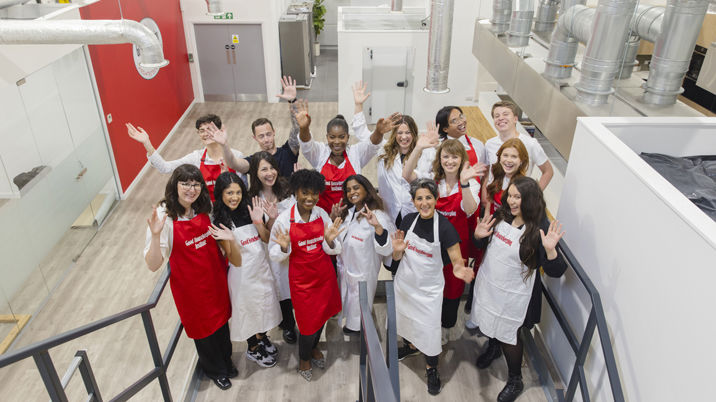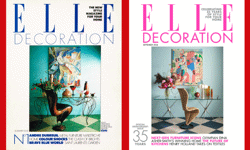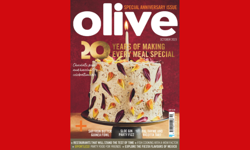
If you are searching for the present-day equivalent of Willy Wonka’s Chocolate Factory, you might find it in a small industrial park on a quiet side street in suburban Feltham. Walk through the unassuming glass doors and you enter a series of pristine kitchens and laboratories where every household appliance and product you can think of is being tested. This is the Good Housekeeping Institute (GHI), where the performance of dishwashers, robot vacuum cleaners, treadmills, wrinkle creams, sleep masks, and even adult toys is precisely measured.
My golden ticket to the GHI in its centenary year is a rare behind-the-scenes open day for the manufacturers and media agencies representing some of the products that are so rigorously tested there.
When Good Housekeeping launched a couple of years before the Institute in 1922, its motto was, “There should be no drudgery around the house”. Today this mantra still holds true.

Our host is Liz Moseley, MD Good Housekeeping / Good Housekeeping Institute, a new role created by Hearst UK CEO Katie Vanneck-Smith. After coffee and pastries in the spotless kitchen area where recipes are put through their paces, we are divided into groups to tour the different zones of the Institute.
First up is the large appliances room with banks of washing machines where different detergents are judged by how they act on pre-prepared sheets of identical stains, as well as dishwashers scored by how well they clean plates using the industry-leading tablets.
From there, we move to robot vacuum cleaners, confined on squares of carpet by wooden pens like small mammals, and set to work removing crushed digestive biscuits, pet hair and trampled Rice Krispies.
Health and wellness covers everything from rowing machines to walking boots, while there is a whole room devoted to sleep, from masks that play music to other, ahem, bedroom paraphernalia.
Upstairs in the beauty room, we are offered the chance to find out the age of our skin using state of the art technology. In our group, a 25-year-old with flawless skin five years younger than her actual age steps forward, and at the grand old age of 48, I don’t dare go next.
Finally, we are given the opportunity to do a blind taste testing of different types of honey; runny, heather and manuka. This takes place in a dedicated all-white room straight out of Wonka’s factory with dividers between seats so that participants are not influenced by their neighbour’s facial expressions. They carry out between four and six tests a week here with a panel of consumers sampling and making notes on around ten products at a time using the hedonic scale in which 1 is faulty, 5 is neutral and 9 is best ever. As they work six months ahead; when I visit in May, they are busy testing edibles for Christmas and Veganuary, with the winners selling out in record time once the results go to press.
Back in the central lobby, we are shown a promotional film for Good Housekeeping demonstrating its intergenerational appeal. Concluding that most readers would rather tidy their shoe racks than have sex with their husbands, it is a fun, light-hearted way to get across the essence of the brand quickly.
Pursuing further growth
In the last five years, Good Housekeeping claims to have enjoyed double digit growth in terms of revenue, with a monthly circulation of 364,870 (ABC: Jan-Dec 2023) and a reported average issue readership of 1.15m. Not wanting to sit on their laurels, new MD Moseley is spearheading a programme of rapid change. This includes a VIP membership club, a new app launched in February, a bigger better Good Housekeeping Live four-day festival at the Business Design Centre in Islington in November, a recipe app launching in the autumn, and digital newsletters around the key pillars of food, shopping, homes, and looks.
There is also a Good Housekeeping YouTube channel with online video series including ‘At Home With’ featuring the houses of well-known celebrities such as Susannah Constantine, ‘Made with Love’ on family cooking, and ‘Inside the Institute’, a peek inside the GHI to mark its 100th anniversary.
If the formula is already working, why fix it? Moseley explains: “When you’re doing well is when you have to do your best work. We need to seize the opportunities we have being now more than double our next nearest competitor in the women’s market. Sitting back and thinking that’s fine, we’ll have a look at it at the end of 2025 isn’t really an option.”
Her first job was working in marketing for women’s glossies including Elle and Red back when they were owned by emap. Working for Hearst UK feels like “coming home” she says, adding that Vanneck-Smith created the new role because Good Housekeeping is such a big brand that it warranted an MD of its own.
Despite its strong heritage, she has been given a change brief. In her first six months, she has run fast with innovation, but there is still a need to go steady. “This is a brand that has endured because it has been so careful about the things that are sacrosanct, so when you come in with a very ambitious growth plan, you do need to tread carefully,” she says.
Inspiration from Selby
She explains that although they do want to continue to grow the brand, they are “less about reach and more about engagement”. They want to enjoy a more direct personal relationship with readers and to grow the value of these customers by creating new products such as the VIP Club that give them the opportunity to spend more money.
“There are women who would spend more money if we created a product to allow them to buy it; we learned that from the launch of GH Live,” says Moseley.
She first had the kernel of an idea for the VIP membership at GH Live last year when she met two women who had come down from Selby in North Yorkshire, best friends for 30 years, both beautifully turned out with pristine blow dries and beautiful silk tops, who were having an absolute hoot.
“They said: ‘It’s nice to come somewhere that’s just for us.’ That’s the insight. These women do everything for everybody else and it’s nice to have something that’s just for them. That’s what we’re trying to do with VIP, which is partly to say ‘thank you’ and partly to create commercially the next tier up, because we know there’s a demand for it.”
While there is an obvious focus on digital, the brand has also had an unexpectedly strong start to the year in print advertising.
“We’ve had a strong first quarter on print advertising, which is brilliant, because it just goes to show that when you take a story to market like we are with GH about our intergenerational audience, there’s a real appetite even in the traditional revenue lines for a business like ours to engage with that.”
When they launched the VIP membership, they soon discovered that one of the key benefits women wanted was to get involved with testing at the GHI by joining its consumer panels.

Laura Cohen, commercial director, Good Housekeeping Institute, has been at the GHI for 14 years. Ten years ago, they constructed a testing space in Soho, but soon outgrew it. So, in 2020, they created this purpose-built facility in a modern warehouse in Feltham, providing all the space they need as well as the capacity for 24-hour deliveries.
Cohen says: “When we first built the space in Soho, that was then a big step forward for Good Housekeeping, to have a physical institute that consumers could come to. We put on events, we had a cookery school, but the test space was limited in its capacity. Coming here gives us this amazing freedom and we’ve got this space that’s completely built to the specification that we wanted and it’s continuing to evolve as we need it to.”
Importance of trust
Implementing rigorous testing processes is something they take extremely seriously, as trust is vital to the brand’s relationship with its customers.
“Our consumers have to trust us, because when they see our logo and they buy that product, that’s their permission to purchase, and it has to live up to the consumer expectations,” she explains.
They mainly deal with big ticket items and products that people will buy again and again. Parenting is one of the new verticals they are exploring this year, as well as aspects of gardening such as robot lawnmowers and outdoor furniture, as these are items people want to last for ten years and be a good investment.

Over the summer, one of Moseley’s tasks is to appoint a new editor-in-chief* as Gaby Huddart has moved on to a new role as editor-at-large, project managing live events for the brand. Moseley sees her job as “less about changing the brand and more about changing the business”. That is why she is so keen for clients to understand the intergenerational nature of their readership rather than pigeonhole them by age.
“There’s so much attitudinally that women have in common across the life stages and the trick for Good Housekeeping is to find that tone that resonates across the board. Women’s lives are so rich and so diverse and so complex — emotionally complex as well as logistically — that there’s such opportunity for us to bring wit and warmth and humour and to cherish that chaos of what women’s lives are really like.”
A century after the launch of the GHI, there is still absolutely no drudgery in sight.
* In July, Jane Bruton was appointed editor-in-chief of Good Housekeeping UK.
This article was first published in InPublishing magazine. If you would like to be added to the free mailing list to receive the magazine, please register here.












